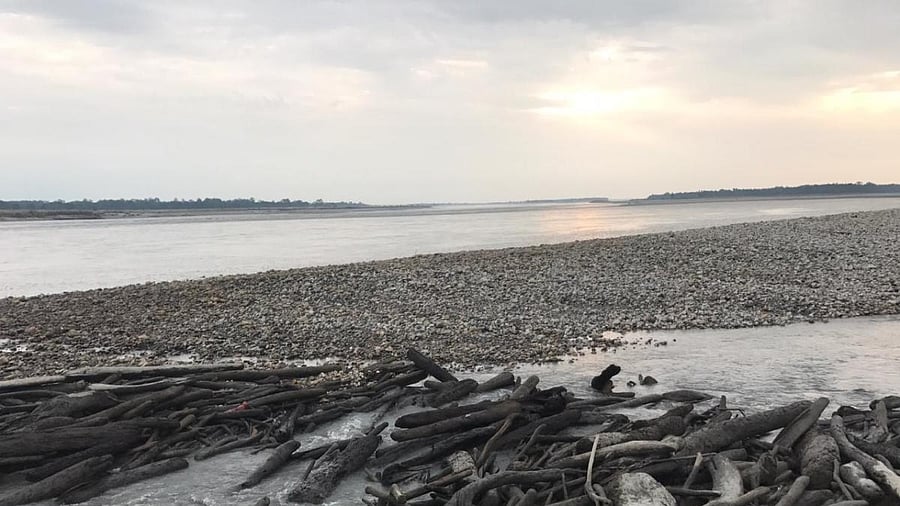
Yarlung Tsangpo river in upper reaches of China that flows into the Siang and Brahmaputra rivers in India.
Reuters
New Delhi: Beijing on Friday defended its plan to go ahead with the construction of a colossal hydropower project on the Yarlung Tsangpo river in the Tibet Autonomous Region of China, promising that it would not have any adverse effects in India and Bangladesh, the two lower riparian nations.
The approval granted by President Xi Jinping’s government to the proposed hydropower project rekindled concerns over the possibility of it diminishing the flow of water into the Siang and Brahmaputra rivers in India.
“China has always been responsible for the development of cross-border rivers,” Mao Ning, the spokesperson of the communist country’s Ministry of Foreign Affairs, said in Beijing. “China’s hydropower development in the lower reaches of the Yarlung Zangbo (Yarlung Tsangpo) river aims to speed up developing clean energy and respond to climate change and extreme hydrological disasters”.
Xinhua reported on Wednesday that the Chinese Government had granted approval to the proposed construction of the hydropower plant in the lower reaches of the Yarlung Zangbo (Yarlung Tsangpo) in Xizang (Tibet) Autonomous Region of the communist country.
The project will play “a positive role in accelerating the country's efforts to create a new development pattern and pursue high-quality development”, the state-run news agency quoted from an official statement issued in Beijing.
The Yarlung Tsangpo, a 1700-km-long river, originates at Jima Yangzong glacier near Mount Kailash in south-western Tibet and flows into Arunachal Pradesh, where it is known as Siang and Dihang, and then into Assam as Brahmaputra.
It later flows into Bangladesh.
New Delhi in the past repeatedly asked Beijing to ensure that the interests of the downstream countries, India and Bangladesh, are not harmed by any activities in the upstream areas in China.
“The hydropower development there has been studied in an in-depth way for decades, and safeguard measures have been taken for the security of the project and ecological environment protection. The project will not negatively affect the lower reaches,” the spokesperson of the Ministry of Foreign Affairs of the Chinese Government said.
The $137 billion project will be built at Medog County of Tibet near China’s disputed boundary with India. It is likely to be constructed in a huge gorge in the Himalayas where the Yarlung Tsangpo makes a huge U-turn to flow into Arunachal Pradesh of India and then to Bangladesh. It is expected to produce three times more energy than the colossal Three Gorges Dam built between 1994 and 2003 on the Yangtze river in central China. With an installed capacity of 22500 MW power, the Three Gorges Dam is at present the largest power station in the world.
“China will continue to maintain communication with countries at the lower reaches through existing channels and step up cooperation on disaster prevention and relief for the benefit of the people by the river,” Mao Ning, the spokesperson of the Chinese government, said.
As a lower riparian state with considerable established user rights to the waters of the Yarlung Tsangpo or Brahmaputra river, India in the past “conveyed its views and concerns” to China, including at the highest levels of the government of the communist country, a source aware of New Delhi’s engagements with Beijing on transboundary rivers, said.
New Delhi and Beijing established an expert-level mechanism in 2006 to discuss various issues relating to transboundary rivers, including the construction of hydropower dams. The last such meeting was held in 2019, before the military stand-off, which started along the Line of Actual Control (LAC) in eastern Ladakh in April-May 2020 and continued for more than four-and-a-half years, took the India-China relations to a new low.
Beijing’s move to build the hydropower project came just a few weeks after its October 21 deal with New Delhi on patrolling by the Indian Army and the Chinese People’s Liberation Army in Depsang and Demchok areas along Line of Actual Control (LAC) marked the end of the four-and-a-half-year long military stand-off in eastern Ladakh.
India and China do not have a water-sharing agreement for the transboundary rivers. The bilateral MoUs for China to share hydrological data about Brahmaputra (Yarlung Zangbo or Yarlung Tsangpo in China) and Sutlej (Lungqen Zangbo) with India have not been renewed since 2018 and 2023 respectively as the bilateral relations nosedived over the military stand-off along the LAC.
China has so far been building only run-of-the-river hydroelectric projects on Yarlung Tsangpo without blocking water flow to India. But the proposal for the construction of the huge hydropower project on Yarlung Tsangpo had triggered concerns in India even when it had been first included in the 14th Five-Year-Plan China adopted in December 2020.
